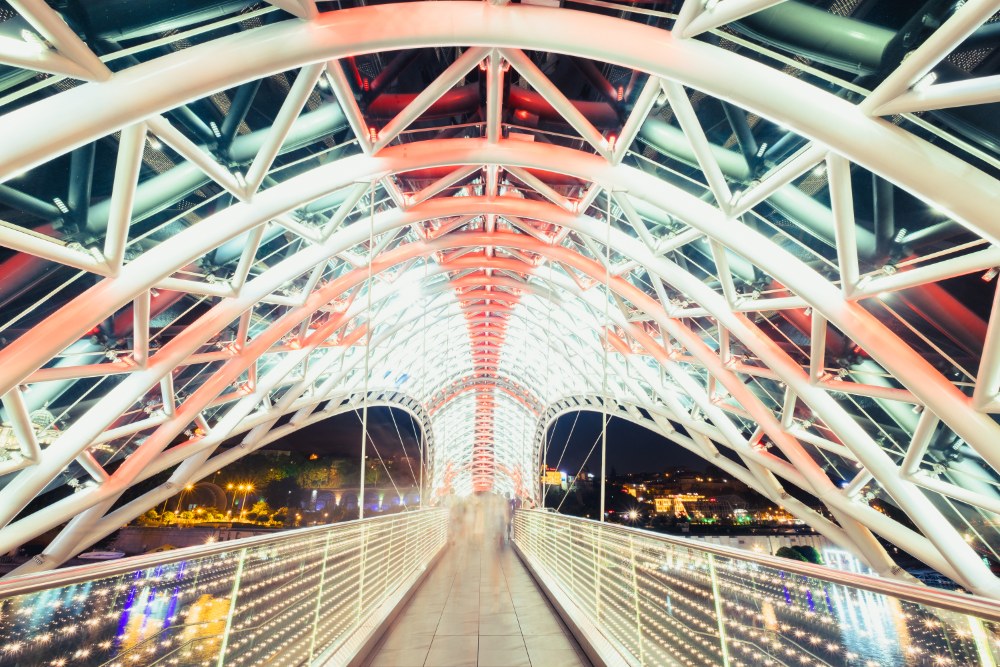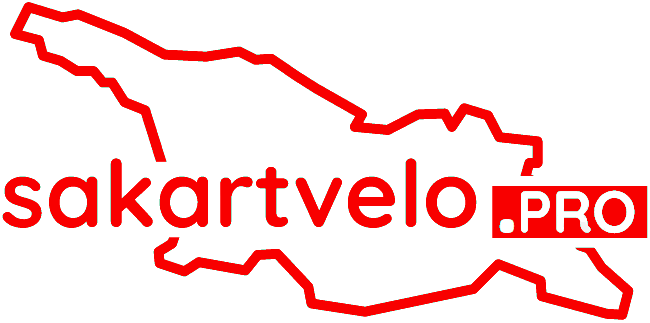
The Bridge of Peace in Tbilisi is a pedestrian bridge over the Mtkvari (Kura) river.
Coordinates: 41.693, 44.80846.
The Bridge of Peace over the Mtkvari River in Tbilisi was conceived and implemented as a symbol of the connection of the Old City with the new time. It has become one of the symbols of the capital, as well as the most recognizable and memorable bridge in Georgia. The official opening took place on May 6, 2010.
The elegant futuristic building looks completely atypical for Georgian architecture. The bridge is designed in such a way that it creates the illusion of lightness and weightlessness. It looks unique and even alien, especially at night, when, illuminated by thousands of lights, it is reflected in the water – a beautiful and mesmerizing sight.
From an architectural point of view, the Peace Bridge is an example of modern architecture, however, it surprisingly fits into the old part of the city, although its design still sometimes causes rejection among some residents of the Georgian capital.
The bridge is a structure of glass panels on a steel frame. The 150 square meter canopy covers a pedestrian area that is only 5 meters wide and 156 meters long.
The architect of the bridge is Italian Michele de Lucchi, who had previously built the Avlabari residence and the building of the Ministry of Internal Affairs in Tbilisi.
The lighting designer was the Frenchman Philippe Martinaud, who designed the lighting for the Ministry of Internal Affairs building, the Presidential Palace and the television tower.
About 50 thousand light bulbs every hour transmit a message encrypted in Morse code, which encodes those elements of the periodic table that are present in the human body. Hence the name – “Bridge of Peace”. Because, despite their appearance and origin, all people are composed of the same elements.
Between transmissions of this light message, other illumination programs operate. The illumination turns on 90 minutes before sunset, illuminating the Kura River and buildings on both banks of the river.
The bridge structure was created in Italy and delivered to Tbilisi on 200 trucks, and the lighting was installed on site during the assembly of the structure.
The roof features 1,208 custom LED luminaires designed and installed by Dutch companies Primo Exposures and RENA Electronica, using 6,040 high-power LUXEON Rebel LEDs with a color temperature of 4,200K.
The glass panels of the railing, which run the entire length of the walkway, are equipped with integrated linear low-power LED arrays, a product called powerglass, supplied by Glas-Platz of Germany.
According to official information, the minimum cost of the bridge was 12.5 million lari, which was allocated from the city budget.
The bridge was built on the initiative of Georgian President Mikheil Saakashvili. The customer was the Tbilisi City Hall. Of the presented projects, Saakashvili chose the most modern and extravagant.
The bridge is located in the very center of the Georgian capital, between the Metekhi and Baratashvili bridges, not far from the cableway leading to Mother of Georgia and the monastery.
On one side of the bridge there is a view of the Metekhi Church, the Narikala fortress and the statue of the city’s founder Vakhtang Gorgasali, on the other – the Baratashvili Bridge and the President’s Office.
Next to the Peace Bridge is Rike Park. For many years, on the territory of the current park there was a wasteland where unreliable individuals gathered. In 2010, almost simultaneously with the construction of the Bridge of Peace, a park was laid out, adorning the city and attracting many people here. From the park you can take a cable car to the Narikala fortress, which offers a magnificent view of the city, as well as to one of the entrances to Botanical Garden.
Near the bridge there is the Tbilisi Balloon attraction, which lifts passengers to a height of 150 meters above the city.
The location of the bridge is very touristy. It is always crowded here and, naturally, there are always guides offering excursions and trips along the Kura River. If you are not ready to enter into lengthy negotiations, say that you have already been everywhere and then they will leave you alone.
You can get to the Bridge of Peace by bus, getting off at the Freedom Square stop. Routes: No. 80, 102, 71, 50, 55, 44 and 31.
You can also take the metro, getting off at the Avlabari station. From here to the Bridge of Peace is no more than ten minutes walk down a beautiful street, with streams of cold water running down the cliff.
The Bridge of Peace is one of the visiting cards of Tbilisi, and guests of the capital are happy to return here again and again.

